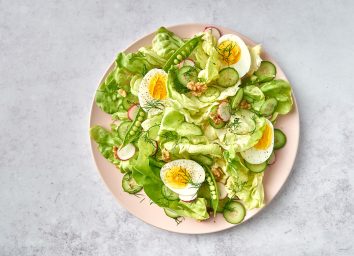
Have you cracked an egg and seen a light yellow, deeper yellow, or even orange color? The color of the yolk can be different for various reasons. Of course when you crack an egg open and the color of the yolk isn't what you're used to—it can make you wonder if it's still safe to eat.
One of the biggest factors that determine the color of the yolk is the feed. A 2022 published study looked at the color of the yolks of two groups of hens. One group of hens was fed a base diet, while the second group was fed a base diet plus an additive of food with carotenoids. The color of the second group was significantly different in terms of lightness and yellowness between the two groups. Researchers determined that dietary carotenoids can help improve the yolk color. To find out more about the various colors of the yolk and find out more about what the color means, I turned to two experts. Read on, and for more, don't miss Here's How Long Eggs Last—and How to Tell If They're Bad.
What the yolk colors tell us.
The color of the yolk is more closely linked to the feed of the hen as opposed to the overall nutritional value of that egg.
"The nutritional value of an egg is determined by factors like its protein content, amino acid profile, and vitamin and mineral content," explains Dr. Fernando Cisneros, Global Manger Layers Solutions at DSM.
While egg yolks can range in color from pale yellow to deep orange, "the healthier hens will have more carotenoids in their eggs, producing a deep golden-colored yolk," Cisneros explains. So to get a golden yolk, the hen needs to get good quality feed, correct husbandry practices—and more importantly be a healthy hen.
Jeanine Flaherty, VP of Food Safety and Quality Assurance at Vital Farms also weighed in and agrees that the yolk color is an indication of a hen's diet and overall well-being. "The Vital Farms girls eat a variety of seasonal vegetation and critters as they roam on pasture, as well as supplemental feed developed by a poultry nutritionist for added protein and nutrients to support their health and active lifestyles."
Should you worry about the varying yolk colors?

Flaherty says you should not be worried about the different colors of the egg yolk as "variation in yolk color is affected by how often, how much, and what hens eat." She explains the variability in the yolk color in Vital Farm hens, "Because Vital Farms girls are pasture-raised, it's natural for yolk color to vary seasonally. In the summer to early fall, the girls tend to eat less due to the warmer temperatures. In the winter, they tend to eat more to stay warm. We do our best to respect the variation that stems from all the variables created by our system of family farming."
Measuring Egg Yolk Color

The poultry industry worldwide uses the DSM YolkFan™ (pictured below). Cisneros explains that it is a simple, accurate, and consistent way of measuring egg yolk color.
When eggs were originally incorporated into the human diet, they were quite expensive and the yolk was expected to be orange as a sign of quality. Post-World War II, poultry feed was wheat-based in Europe, which meant the egg yolks were not yellow enough for the European consumer.
"DSM YolkFan™ has played a critical role in establishing the basis of a standardized system for measuring yolk color from the farm to the consumer's kitchen table," says Cisneros. "The latest version was launched in 2016, with the YolkFan™ now including 16 blades, to reflect the growing requirement of the market for a deeper shade of orange in the yolk."
Looking at Vital Farms egg yolk, Flaherty says that "Vital Farms' goal is for our yolks to score 9-11 on the scale, a rich yellow color."
Bottom Line:
Most consumers in the U.S. do want a darker egg yolk, but it is a misconception that it is linked to the nutrition of the eggs. The darker yolk means the hens ate plenty of feed with a yellowish-orange pigment called xanthophylls (which is part of their feed).
So whichever yolk color you prefer, all have an enormous amount of nutrition. As food prices are quite high, I will rotate between warehouse-store bulk eggs and some more expensive brands—it just depends on my food budget for the month. No matter the color yolk you choose, you're getting plenty of good egg nutrition.









